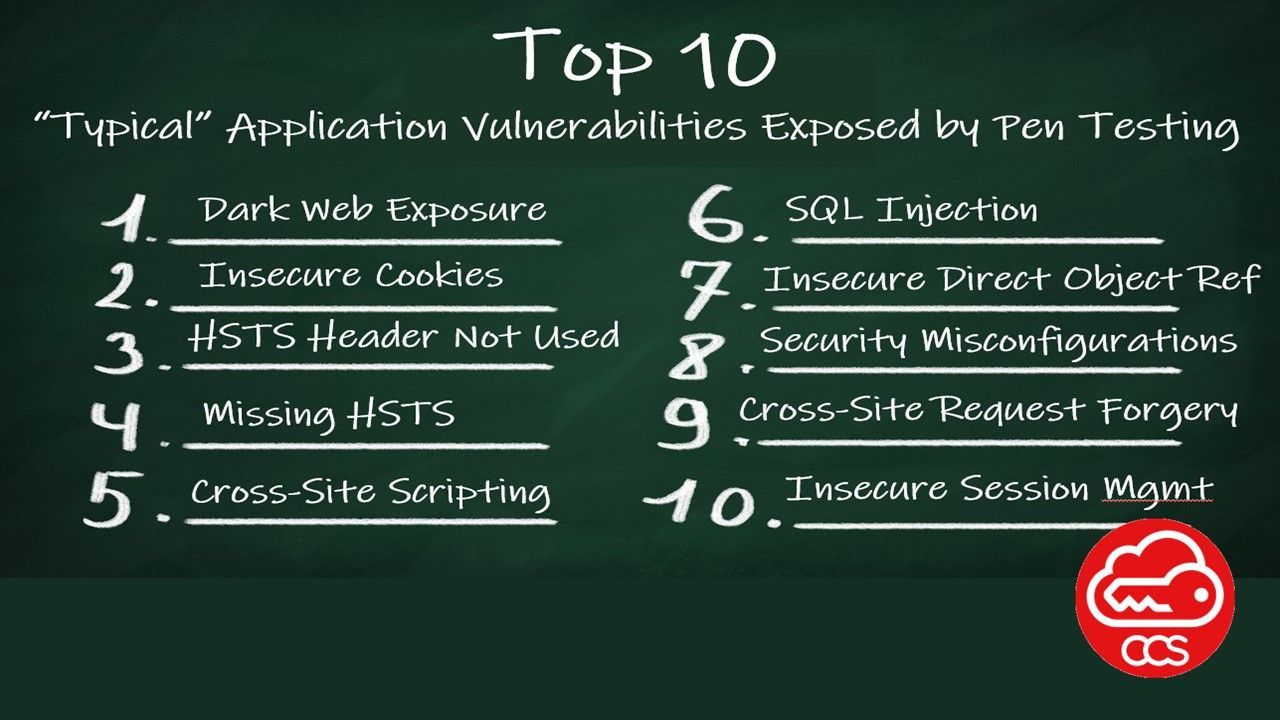Penetration testing is an essential process for identifying vulnerabilities in IT environments, applications, and systems. By simulating an attack on these systems, penetration testing allows organisations to identify weaknesses and potential security gaps that could be exploited by attackers. Uncover the key reasons why organisations should conduct penetration testing.
Typical Top 10 Application Vulnerabilities Exposed by Pen Testing
In today's digital landscape, ensuring the security and resilience of web applications is paramount for businesses. Penetration testing plays a crucial role in identifying vulnerabilities and assessing the overall security posture of an application. This article focuses on the "Typical" top 10 application vulnerabilities commonly uncovered during penetration testing.
While the OWASP Top 10 is widely recognised as the industry standard for identifying the most critical risks to web applications, this article aims to shed light on the vulnerabilities that are commonly encountered during pen testing engagements. By addressing these common vulnerabilities, organisations can significantly enhance their application security.
We will delve into each of these typical top 10 application vulnerabilities, discussing their potential impact on businesses and providing practical strategies to address them effectively. While the OWASP Top 10 serves as an essential reference for critical vulnerabilities, it is essential to consider these typical vulnerabilities as part of a comprehensive security approach.
By familiarising themselves with these common vulnerabilities and implementing robust security measures to mitigate them, organisations can fortify their web applications, protect sensitive data, and maintain the trust of their users. Let's now explore the typical top 10 application vulnerabilities exposed by pen testing and delve into actionable steps to address them.
Neglecting to perform proper penetration testing on a web application can have significant consequences. The following highlights the potential risks and negative outcomes that organisations may face when vulnerabilities in their applications go undetected:
- Increased Risk of Data Breaches:
- Application vulnerabilities provide entry points for attackers to gain unauthorised access to sensitive data. Without proper testing, these vulnerabilities can go undetected, leaving organisations susceptible to data breaches that can result in financial loss, legal liabilities, and damage to their reputation.
- Compromised Customer Trust:
- Customers trust businesses with their personal information, and any breach that exposes this data erodes that trust. Without robust security measures in place, businesses risk damaging their relationship with customers, leading to customer churn and a negative impact on brand reputation.
- Regulatory Compliance Issues:
- Many industries are subject to strict data protection regulations. Failure to identify and address application vulnerabilities can result in non-compliance with these regulations, leading to potential fines, legal consequences, and reputational damage.
- Disruption of Business Operations:
- Application vulnerabilities can be exploited to disrupt critical business operations. Attackers may inject malicious code, initiate denial-of-service attacks, or gain unauthorised control over the application. Such disruptions can result in significant financial losses, downtime, and a loss of productivity.
- Costly Incident Response:
- Responding to security incidents can be a time-consuming and costly process. Without proactive testing, organisations may find themselves scrambling to investigate and remediate vulnerabilities after an incident occurs, incurring higher costs for incident response and recovery.
By conducting regular application penetration testing, businesses can proactively identify vulnerabilities, implement appropriate security measures, and reduce the risk of security breaches. It allows organisations to stay ahead of potential threats, protect sensitive data, and maintain a strong security posture.
In the following sections, we will explore the top 10 application vulnerabilities exposed by penetration testing and discuss effective strategies to address them. By understanding these vulnerabilities and taking the necessary steps to mitigate them, businesses can ensure the security and integrity of their applications, providing a solid foundation for their digital operations.
- Dark Web Password Exposure:
- The presence of users' passwords in cleartext on the dark web exposes them to potential compromise. To mitigate this risk, it is crucial to implement strong password hashing algorithms such as bcrypt or Argon2, along with salting techniques. Regularly validating the strength of users' passwords and enforcing password policies that promote complexity adds an extra layer of protection.
- Insecure Cookie Configuration:
- Insecure cookie settings can lead to cookie theft or session hijacking, making them a significant vulnerability. To address this issue, ensure secure cookie configuration by enabling secure flags, setting HTTPOnly to prevent client-side scripting access, and employing SameSite attributes to control cookie behavior.
- Lack of HTTP Strict Transport Security (HSTS) Header:
- The absence of HSTS headers exposes the application to downgrade attacks and Man-in-the-Middle (MitM) attacks. It is crucial to implement HSTS headers to enforce secure connections over HTTPS, ensuring that all subsequent requests are made securely.
- Missing HSTS from HTTPS Server:
- Failure to deploy HSTS on the server leaves the application vulnerable to protocol downgrade attacks. To mitigate this risk, configure the server to include HSTS headers and set an appropriate max-age value to instruct web browsers to always use HTTPS.
- Cross-Site Scripting (XSS):
- Cross-Site Scripting vulnerabilities allow attackers to inject malicious scripts into web pages viewed by users, potentially leading to unauthorised actions or data theft. To mitigate this risk, it is important to apply input validation, sanitise user-generated content, and implement output encoding. Additionally, using Content Security Policy (CSP) can help restrict the execution of scripts.
- SQL Injection:
- The lack of input validation exposes applications to SQL injection attacks, allowing attackers to manipulate SQL queries and gain unauthorised access or manipulate the database. To prevent this, utilise prepared statements or parameterised queries, apply strict input validation, and avoid dynamically constructing queries using user-supplied data.
- Insecure Direct Object References:
- Insecure object references expose sensitive information or allow unauthorised access to restricted resources. To address this vulnerability, it is essential to implement access controls and proper authorisation mechanisms. Validating user permissions before accessing sensitive objects and using indirect references instead of directly exposing internal identifiers enhances security.
- Security Misconfigurations:
- Inadequate security configurations, such as default credentials, unused services, or exposed debug information, increase the attack surface. To mitigate this risk, conduct regular security audits, perform comprehensive system hardening, remove or disable unnecessary services, apply secure configurations, and promptly patch vulnerabilities.
- Cross-Site Request Forgery (CSRF):
- CSRF attacks trick authenticated users into performing unintended actions, potentially leading to unauthorised data modifications or account compromise. To prevent such attacks, implement measures like CSRF tokens to validate requests and perform referrer header checks to verify the request origin. Employing the "SameSite" attribute for cookies also helps mitigate CSRF attacks.
- Insecure Session Management:
- Weak session management can lead to session hijacking, fixation, or unauthorised access to sensitive data. To strengthen session management, it is essential to implement secure practices such as using randomly generated session IDs, secure storage, session regeneration after authentication or privilege level changes, setting appropriate session expiration times, and ensuring effective session termination.
Our Penetration Testing Services:
CCS offers expert application penetration testing services to help organisations identify and address the top 10 application vulnerabilities mentioned above. Our team at CCS comprises experts in software development and software security, giving us unique insights into how applications are constructed and potential vulnerabilities that can be exploited. We specialise in conducting thorough penetration tests on various types of applications, including bespoke in-house developed applications and Commercial Off-The-Shelf (COTS) products.
Our application penetration testing services cover a wide range of application types, including cloud-based, managed services, hosting, thin client, client/server, and thick client applications. We apply a combination of manual testing techniques and automated tools to simulate real-world attack scenarios, identifying vulnerabilities that may not be evident through standard security measures.
If your organisation is running legacy applications that are no longer supported by vendors, we can provide Legacy Application Security solutions. These solutions help you secure and protect your legacy applications without the need for expensive re-engineering or re-platforming efforts.
By leveraging our application penetration testing services, you can proactively identify and address critical vulnerabilities, safeguard sensitive data, and enhance the overall security posture of your applications.
Don't wait for a security breach to occur. Take proactive measures to secure your applications today. Contact us to leverage our expertise in application penetration testing and safeguard your critical business assets.





